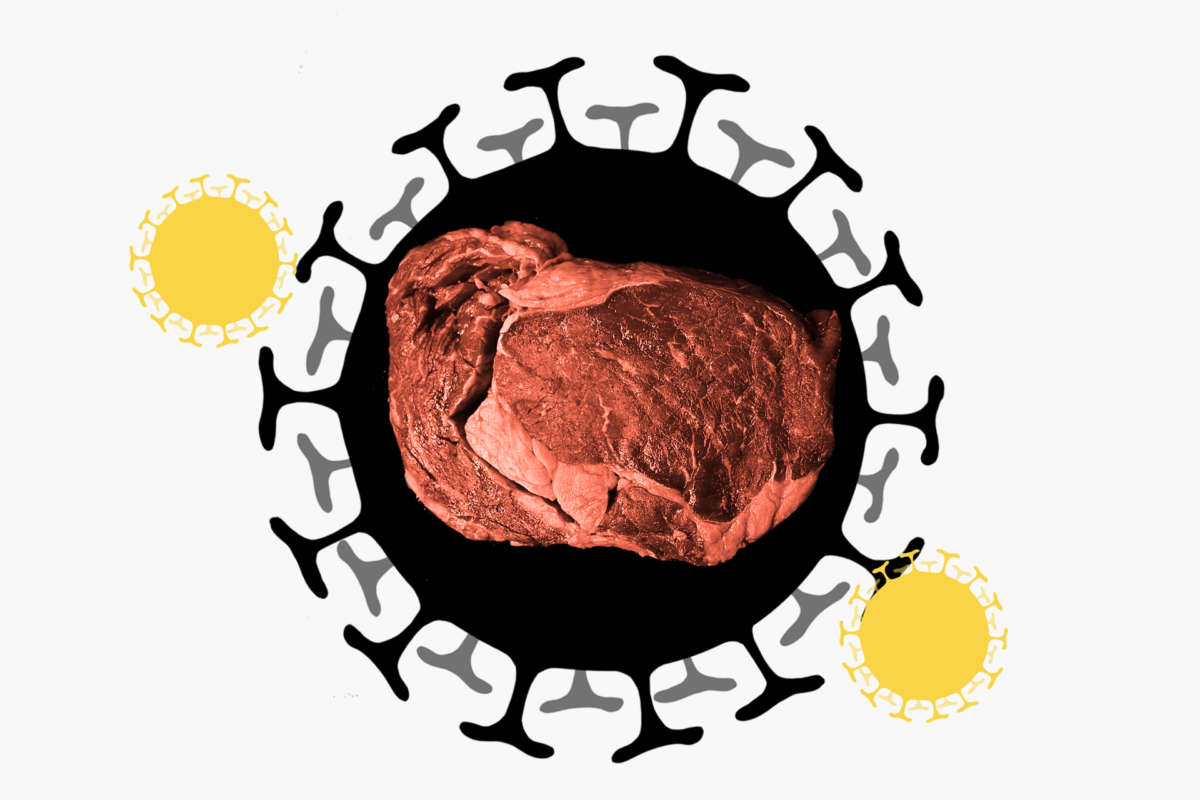In late April, as COVID-19 raced through meatpacking plants sickening and killing workers, President Donald Trump issued a controversial executive order aimed at keeping the plants open to supply food to American consumers.
It was a relief for the nation’s meatpackers who were being urged, or ordered, to suspend production by local health officials worried about the spread of the coronavirus.
But emails obtained by ProPublica show that the meat industry may have had a hand in its own White House rescue: Just a week before the order was issued, the meat industry’s trade group drafted an executive order that bears striking similarities to the one the president signed.
The draft that Julie Anna Potts, the president of the North American Meat Institute, sent to top officials at the U.S. Department of Agriculture was written using the framework of an official executive order and stressed the importance of the food supply chain and how outbreaks had reduced production — themes later addressed in the president’s order.
It invoked the president’s powers under a Korean War-era law known as the Defense Production Act and proposed that the president make a simple and straightforward proclamation: “I hereby order that critical infrastructure food companies continue their operations to the fullest extent possible.”
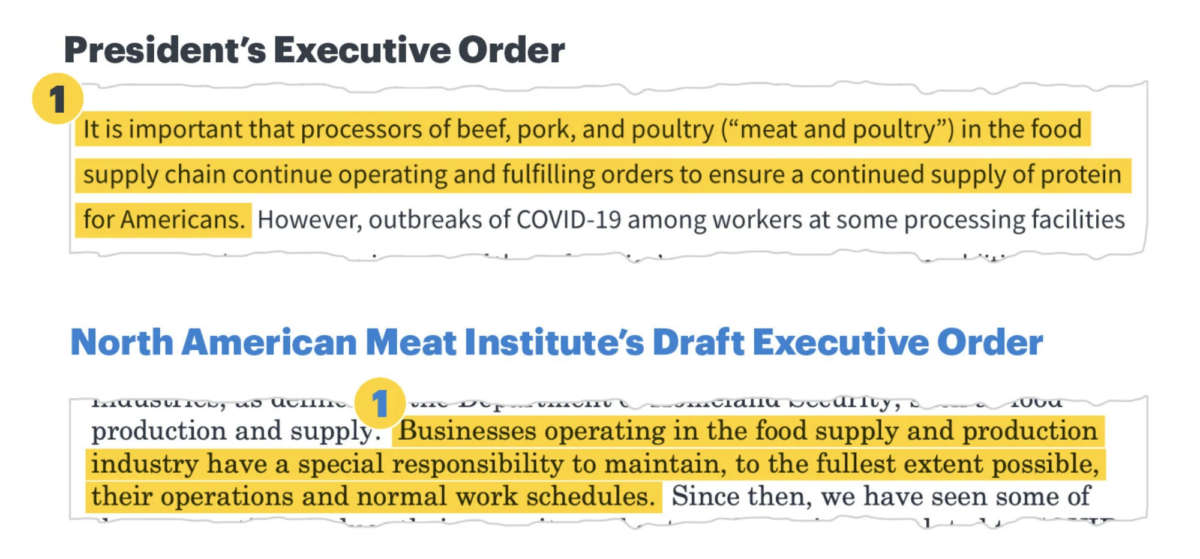
What happened next within the USDA and White House isn’t clear from the records. The USDA declined to answer questions, and the White House did not respond to requests for comment. But while the final wording wasn’t verbatim, Trump’s order emphasized the points the industry had proposed and furthered the same goal, directing the agriculture secretary to take action “to ensure that meat and poultry processors continue operations.”
The order provided a lifeline for meatpacking companies stressed by dozens of plant closures, severe staffing shortages and supply chain disruptions that would cause fast food restaurants to run out of hamburgers and grocery stores to ration meat purchases.
But it has also generated significant criticism from labor unions and Democratic senators who said it prioritized the bottom line of the nation’s meatpackers over the health of their workers.
The executive order effectively provided a justification, sanctioned by the White House, for meat companies to continue operations even as tens of thousands of the industry’s workers contracted the disease.
“It certainly gives rise to at least the appearance of favoritism that the executive order was done not because the White House thought it was the right thing to do but because they were getting pressure from outside groups that wanted it done,” said Stephen Vladeck, a constitutional law professor at the University of Texas at Austin.
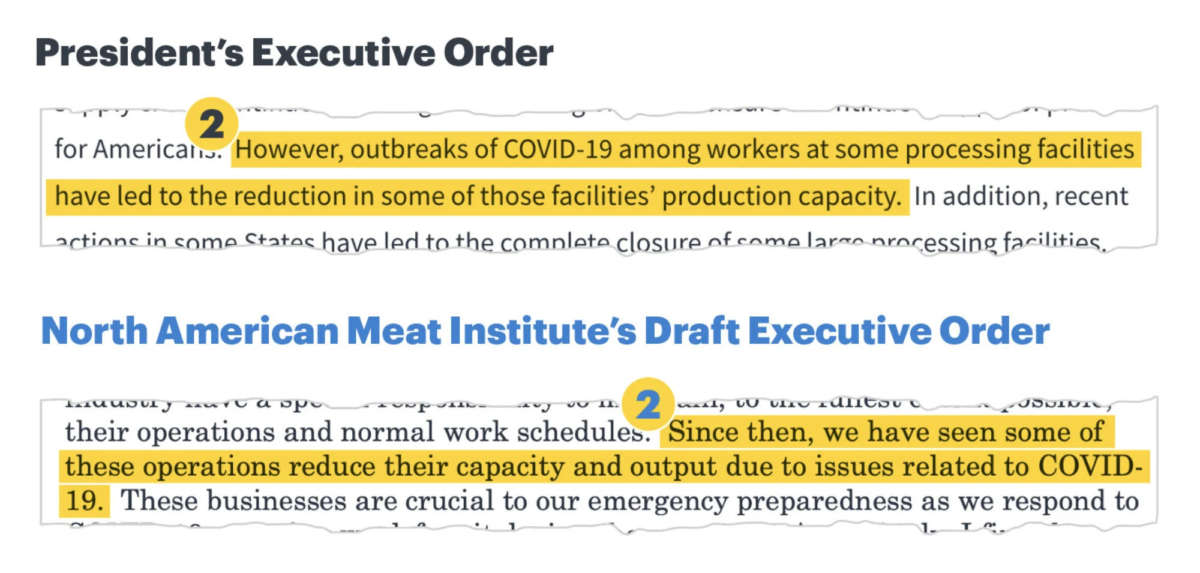
In a statement, Potts said that the meat institute had been working as a liaison between the government and industry on many issues related to COVID-19. “Trade associations of all types routinely suggest legislative language, comment on proposed rules, and other provisions that are shared with the government,” she said.
The documents obtained by ProPublica offer a rare look at the process of drafting an executive order and a glimpse into the meat industry’s influence and access to the highest levels of government. Such political support has been crucial for the industry, which had dismissed years of warnings from the federal government to plan for a pandemic, sowing chaos in rural communities as they battled local health departments over outbreaks in their plants.
The draft executive order was one of hundreds of emails between the companies, industry groups and top officials at the USDA since March. Together, they show that throughout the coronavirus crisis, the meatpacking industry has repeatedly turned to the agency for help beating back local public health orders and loosening regulations to keep processing lines running.
While special interest groups often submit draft legislation and regulations to policymakers, legal experts said executive orders are less common and aren’t subject to the same public scrutiny.
In interviews, former White House lawyers from Democratic and Republican administrations said that there is great latitude in how executive orders are generated and it wasn’t unusual for private interest groups of all types to promote their causes by pushing for an executive order. It is also reasonable for the White House to seek input from outside entities during the process. But there would typically be an effort to consult a range of parties who might be affected by it before the order received legal scrutiny, they said. The quick seven-day turnaround, even amid an emergency like COVID-19, is notable, some said.
“All policy is shaped by people who have a stake in it,” said Rakesh Kilaru, associate counsel and special assistant to President Barack Obama from 2015 to 2017. “But I can’t think of something that was so direct between the stakeholder asking for action and getting it.”

Jonathan Adler, a constitutional and administrative law professor at Case Western Reserve University, said there’s nothing “inherently inappropriate” about the industry helping to draft the order. “The concern is that, in a case like this, if the executive order is slanted to a particular interest rather than the public at large,” he said.
The United Food and Commercial Workers union, which represents workers responsible for the majority of U.S. beef and pork production, said no one from the White House or the USDA sought its input before the executive order was issued.
Mark Lauritsen, the UFCW’s director of food processing, packing and manufacturing, said he believes the Meat Institute “along with some of the other bigger players in the industry pulled every lever they could.”
The order has been effective as a political tool because it is widely perceived to have far more legal force than it actually does. From a legal standpoint, the executive order gave Agriculture Secretary Sonny Perdue additional power to issue his own orders related to the food supply — something he hasn’t done.
But many state and local health officials view the order as superseding their authority or decided to back off in the face of political pressure from the Trump administration. Within a week of the executive order, the USDA was working with companies and local health authorities to reopen shuttered plants. With workers back on the line, operations ramped up again. Pork production, for example, had fallen by more than half by the end of April, causing steep financial losses. But by early June, meatpacking plants were nearly back to capacity.
Since the order, however, COVID-19 infections among meatpacking workers have multiplied. To date, there have been more than 43,000 cases and at least 195 deaths among meatpacking employees, according to data compiled by ProPublica from public health agencies and news reports.
Documents obtained under the Freedom of Information Act show that almost from the start of the crisis, the meatpacking industry and the USDA were largely focused on how to keep workers on the line.
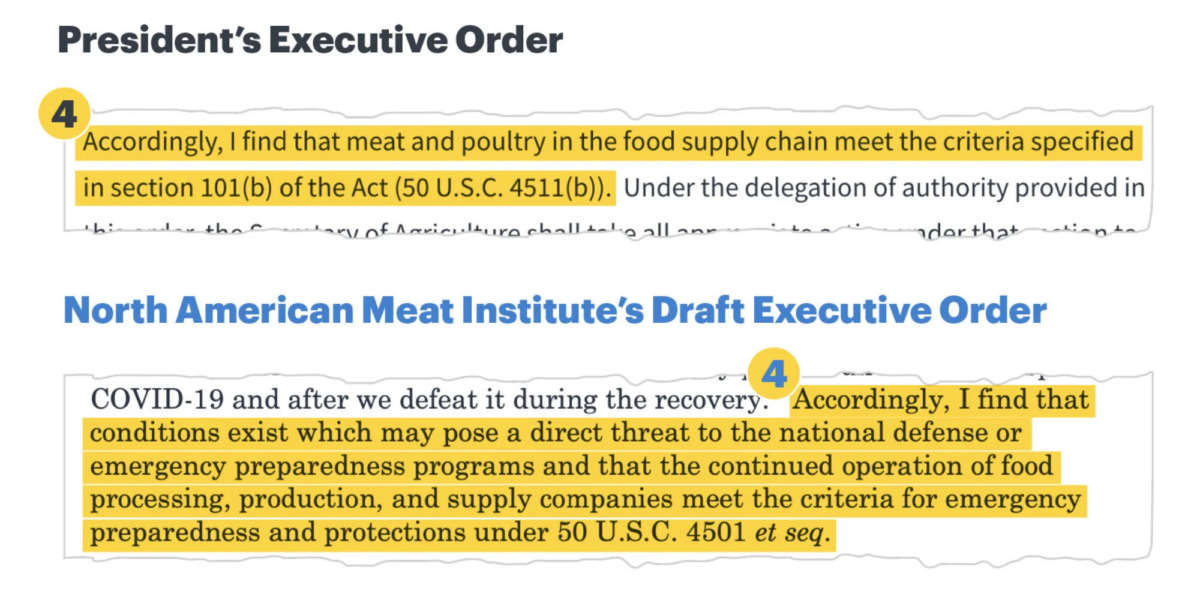
In March, governors across the country tried to stem the spread of COVID-19 with shelter-in-place orders, coming up with their own varied lists of essential industries. Companies were sometimes faced with unclear and conflicting directives. This was especially true in meatpacking, a highly consolidated industry where a handful of companies run multiple operations across the country with hundreds of employees working side by side.
To seek clarity, 60 food and agricultural trade groups sent a letter on March 18 to federal, state and local officials asking for exemptions from curfews and public gathering bans so they could keep their businesses running. Copies of the letter were sent to the White House and members of Congress, and Tyson Foods circulated it among several governors.
The next day, the Department of Homeland Security issued guidance and noted Trump’s previous comments that “if you work in a critical infrastructure industry, as defined by the Department of Homeland Security, such as healthcare services and pharmaceutical and food supply, you have a special responsibility to maintain your normal work schedule.”
But the meatpacking companies soon found themselves facing another hurdle. By April, waves of workers who debone chickens or carve up pork elbow-to-elbow with their co-workers were falling ill from the virus. Some feared coming to work while others walked out of plants to protest the lack of infection control measures.
With plant slowdowns came a backlog of pigs, cows and chickens waiting for slaughter. Millions of animals had to be euthanized.
As some plants partially suspended operations or contemplated closing because of staffing shortages, Potts of the Meat Institute arranged an April 3 call between Perdue and top executives of major meatpacking firms Tyson, Smithfield Foods, Hormel, JBS, Seaboard and Cargill. Before the call, Potts emailed the USDA’s undersecretary for food safety, Mindy Brashears, with a list of discussion topics, including clear messaging that employees who failed to show up for work because they were scared would not qualify for unemployment benefits.
“I want to re-emphasize that the slowdowns and shutdowns you heard described today are significant and getting worse each day,” Potts wrote in a follow-up email. “Hearing a strong and consistent message from the President or Vice President like that delivered by the Governor of Nebraska yesterday is vital: being afraid of COVID-19 is not a reason to quit your job and you are not eligible for unemployment compensation if you do.”

Two days later, the Labor Department, which had been hearing similar complaints from across the business community, issued guidance clarifying that workers who quit to avoid contracting the disease wouldn’t receive jobless benefits.
As outbreaks overwhelmed hospitals in April, pressure from local public officials grew, leading to the rapid-fire closures of some of the nation’s largest slaughterhouses.
The threat of closure led the meatpacking industry to ramp up its efforts to seek intervention not only from the USDA but from other government officials as well. Emails obtained by ProPublica show that as state and local health officials sought to order JBS to shut down its Greeley, Colorado, plant, the company appealed to Gov. Jared Polis and then to Vice President Mike Pence.
State health director Jill Hunsaker Ryan told the head of the county Health Department that she had received a call from Robert Redfield, the director of the Centers for Disease Control and Prevention.
“JBS was in touch with the VP who had Director Redfield call me,” she wrote in an email, first reported by The Denver Post. “They want us to use CDC’s critical infrastructure guidance, (sending asymptomatic people back to work even if we suspect exposure but they have no symptoms) even with the outbreak at present level.”
JBS said that it reached out to Pence because it was “receiving guidance from local authorities that conflicted with federal CDC guidance,” but that it ultimately agreed to shut down the plant to “stop any potential chain of infection.”
Tyson and National Beef made similar appeals to the Kansas Department of Agriculture when the state Health Department wanted workers to stay off the line for two weeks if they had come in contact with a positive COVID-19 case, public records first reported by The Kansas City Star and The Wichita Eagle show. The state’s secretary of agriculture coordinated with meat companies and the director of the Kansas Department of Health and Environment, who then agreed to follow the less-strict CDC guidance.
Despite these varied efforts to keep plants open, absenteeism and public health orders continued to cripple production lines. Government experts had long predicted a pandemic would cause food shortages. And those worst-case scenarios were now playing out.
The major meat and agriculture trade groups, including the American Farm Bureau Federation, the National Cattlemen’s Beef Association and the Meat Institute, wanted the White House to get directly involved in preventing plant closures.
In an April 17 letter to Trump, they detailed the disruptions caused by plant closures and the inconsistency of health and safety actions from state to state — a point later echoed in the executive order.
“To ensure livestock producers, poultry growers, and all food processors and their workers can continue to feed the nation,” they wrote, “we respectfully request you emphasize the importance of allowing critical infrastructure food companies to responsibly and safely continue their operations to the fullest extent possible without undue disruption.”
For emphasis, Potts of the Meat Institute followed up with an email to Stephen Censky, the USDA’s deputy secretary, who led the American Soybean Association before joining the Trump administration. She attached the letter to Trump and added, “The situation is continuing to get worse and worse at the local level (it’s hard to overstate how dire it is) and I want to explore with you what might be possible as a tool to help.”
Early the next morning, Potts had a call with top officials from the USDA, and shortly after 9 a.m., she sent them an email, writing: “Attached is a draft EO for consideration.”
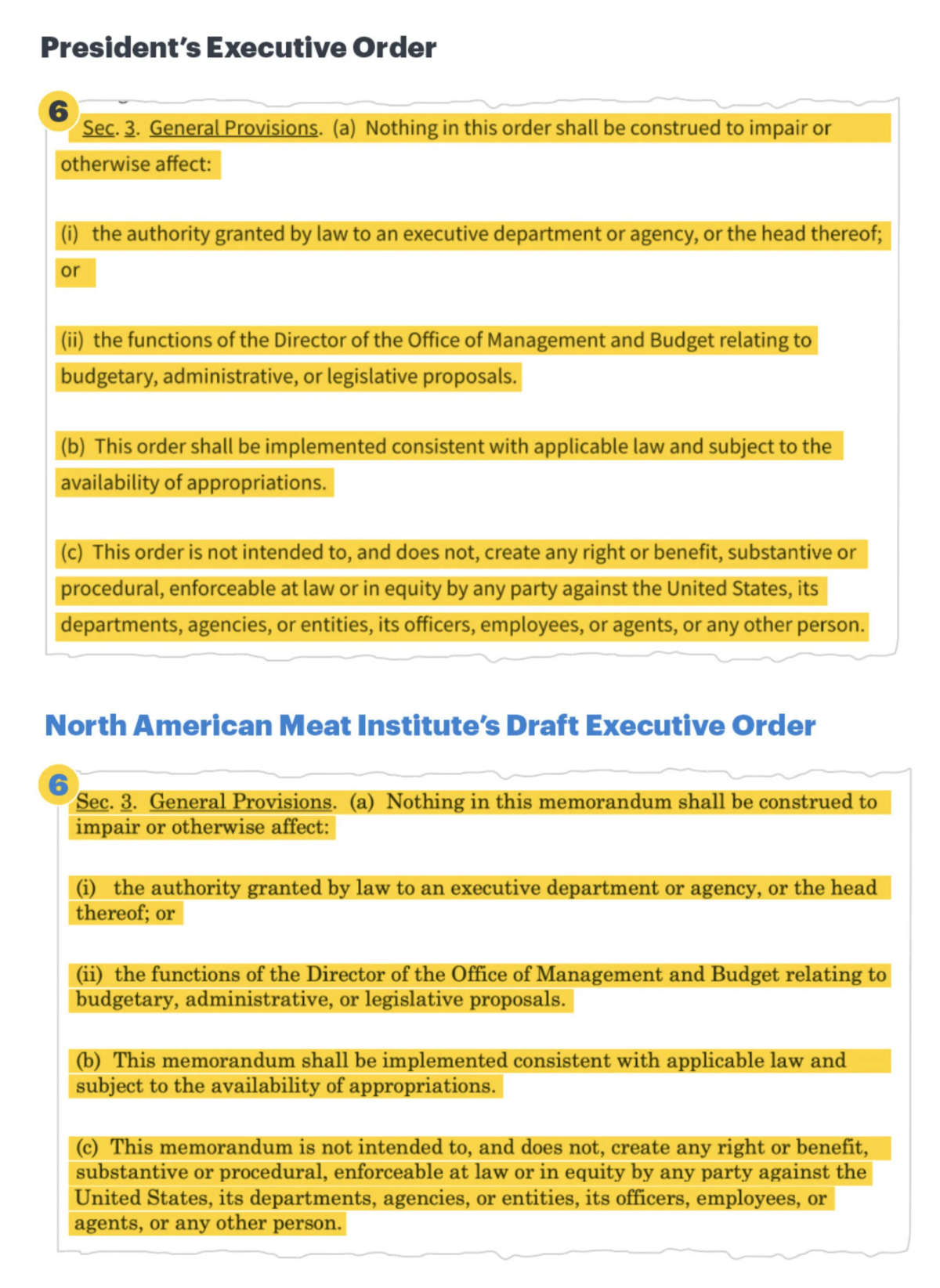
The records don’t include a reply, and White House and internal deliberative agency conversations are exempt from public records laws, making it difficult to verify how much or little influence the meat industry’s draft had on the final executive order.
But over the next week, the drumbeat for action on behalf of the food and agriculture sector continued. Governors from the poultry producing states of Delaware, Maryland and Virginia wrote to Trump asking for the designation of one federal agency to lead on COVID-19 and poultry workers, access to protective equipment and financial relief for farmers and companies. Industry representatives convened a call with the USDA, the Food and Drug Administration and DHS about the impending disaster facing farmers, who would need to mass euthanize their animals if plants remained shuttered. In that conversation, utilizing the Defense Production Act was discussed, according to an industry representative on the call. Tyson took out a full-page ad in major newspapers to warn that the food supply chain was breaking.
Even on the day the executive order was issued, there was still a flurry of activity to get the White House to help the meat industry. That afternoon, records show, the director of the Washington office for North Carolina Gov. Roy Cooper forwarded a letter from pork producers to his counterparts in Michigan, Illinois, Minnesota, Colorado and Pennsylvania to ask their opinion on it and whether their governors were going to sign on.
The draft letter, addressed to Pence, asks for his help in invoking the Defense Production Act to assist in “the humane euthanasia of animals,” to indemnify farmers and pork producers and to “utilize every authority available to keep plants open.”
A representative from Michigan said her state would pass, noting the lack of worker protection language in the letter, while an aide to Pennsylvania’s governor cited the need for “advocacy on behalf of all sectors.”
On April 28, a week after Potts sent the suggested language for an executive order, Trump issued the “Executive Order on Delegating Authority Under the DPA with Respect to Food Supply Chain Resources During the National Emergency Caused by the Outbreak of COVID-19.”
Trump’s final order reflects what the meat industry had been requesting for weeks as the pandemic had unfolded: “It is important that processors of beef, pork, and poultry (‘meat and poultry’) in the food supply chain continue operating and fulfilling orders to ensure a continued supply of protein for Americans.”
It also notes that “recent actions in some States have led to the complete closure of some large processing facilities” and that such closures “threaten the continued functioning of the national meat and poultry supply chain, undermining critical infrastructure during the national emergency.”
The order invokes the Defense Production Act and orders the agriculture secretary to “take all appropriate action under that section to ensure that meat and poultry processors continue operations consistent with the guidance for their operations jointly issued by the CDC” and the Occupational Safety and Health Administration.
It had immediate effect.
In June, the Bear River Health Department in northern Utah, where nearly 400 JBS workers have tested positive for COVID-19, told the press it couldn’t shut the plant down because of the executive order.
In Virginia, state health officials had initially recommended that poultry companies close their plants for two weeks, “allowing deep cleaning and allowing symptomatic and asymptomatic infected workers to run their course of disease and recover,” records obtained under a separate public records request show. But the state backed off “to maintain the critical food production infrastructure.”
Meanwhile, meat companies and their trade groups continued to seek help from the USDA when public health officials tried to take action.
The day after the executive order was announced, the National Chicken Council wrote to the USDA with complaints that the county Health Department in Chattanooga, Tennessee, was requiring testing of all employees at poultry plants in the area. This would have the effect of closing down the plants, the trade group warned, because they were already short-staffed and testing could cause fear among the remaining workers.
Weeks later, the Chicken Council wrote that local officials were threatening plant closures and issuing public notices because they believed the plants were “operating with an imminent health hazard.”
“We want to push back on 100% testing and would like your assistance,” the trade group wrote.
The Chicken Council didn’t return calls or emails seeking comment.
Smithfield also went to the USDA for help dealing with a local public Health Department in Kane County, Illinois, which had closed the plant days before Trump’s executive order was issued. “The Kane County Illinois health department continues to be a challenge regarding our St. Charles processing facility,” Michael Skahill, Smithfield’s vice president of government affairs, wrote to Brashears, the USDA’s undersecretary for food safety. “I really did not want to have to get you involved but it has now come to the point where we need you to referee.”
Asked why it had gone to the USDA to intervene, Keira Lombardo, Smithfield’s executive vice president for corporate affairs, said: “We are a leading American agriculture company. Considering that fact, why wouldn’t we engage with the United States Department of Agriculture amid an unprecedented pandemic?”
Two days after Skahill’s plea for help, Smithfield continued to press the issue. Amy McClure, Smithfield’s associate general counsel, wrote to Brashears again, this time citing a central tenet of the executive order. “To reiterate our conversation, our St. Charles plant in Kane County, Illinois is in an urgent situation,” McClure wrote. “We need to reopen to prevent further disruption in the nation’s food supply.”
Six hours later, Brashears and her chief of staff received a grateful email from Skahill. “Thank you for your support today with the Smithfield St. Charles Kane County issue,” he wrote. “I think we have a resolution that will allow us to process next week and put protein on America’s table.”
Mollie Simon and Claire Perlman contributed reporting. Graphics by Moiz Syed.
We’re not backing down in the face of Trump’s threats.
As Donald Trump is inaugurated a second time, independent media organizations are faced with urgent mandates: Tell the truth more loudly than ever before. Do that work even as our standard modes of distribution (such as social media platforms) are being manipulated and curtailed by forces of fascist repression and ruthless capitalism. Do that work even as journalism and journalists face targeted attacks, including from the government itself. And do that work in community, never forgetting that we’re not shouting into a faceless void – we’re reaching out to real people amid a life-threatening political climate.
Our task is formidable, and it requires us to ground ourselves in our principles, remind ourselves of our utility, dig in and commit.
As a dizzying number of corporate news organizations – either through need or greed – rush to implement new ways to further monetize their content, and others acquiesce to Trump’s wishes, now is a time for movement media-makers to double down on community-first models.
At Truthout, we are reaffirming our commitments on this front: We won’t run ads or have a paywall because we believe that everyone should have access to information, and that access should exist without barriers and free of distractions from craven corporate interests. We recognize the implications for democracy when information-seekers click a link only to find the article trapped behind a paywall or buried on a page with dozens of invasive ads. The laws of capitalism dictate an unending increase in monetization, and much of the media simply follows those laws. Truthout and many of our peers are dedicating ourselves to following other paths – a commitment which feels vital in a moment when corporations are evermore overtly embedded in government.
Over 80 percent of Truthout‘s funding comes from small individual donations from our community of readers, and the remaining 20 percent comes from a handful of social justice-oriented foundations. Over a third of our total budget is supported by recurring monthly donors, many of whom give because they want to help us keep Truthout barrier-free for everyone.
You can help by giving today. Whether you can make a small monthly donation or a larger gift, Truthout only works with your support.
